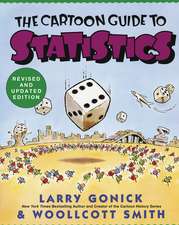An Introduction to Generalized Linear Models: Quantitative Applications in the Social Sciences, cartea 145
Autor George Henry Dunteman, Moon-Ho R. Hoen Limba Engleză Paperback – noi 2005
Din seria Quantitative Applications in the Social Sciences
-
 Preț: 306.08 lei
Preț: 306.08 lei -
 Preț: 270.02 lei
Preț: 270.02 lei -
 Preț: 270.25 lei
Preț: 270.25 lei -
 Preț: 274.06 lei
Preț: 274.06 lei -
 Preț: 270.29 lei
Preț: 270.29 lei -
 Preț: 304.51 lei
Preț: 304.51 lei -
 Preț: 304.83 lei
Preț: 304.83 lei -
 Preț: 313.80 lei
Preț: 313.80 lei -
 Preț: 305.60 lei
Preț: 305.60 lei -
 Preț: 304.77 lei
Preț: 304.77 lei -
 Preț: 306.14 lei
Preț: 306.14 lei -
 Preț: 273.46 lei
Preț: 273.46 lei -
 Preț: 275.42 lei
Preț: 275.42 lei -
 Preț: 277.33 lei
Preț: 277.33 lei -
 Preț: 305.05 lei
Preț: 305.05 lei -
 Preț: 271.10 lei
Preț: 271.10 lei -
 Preț: 270.63 lei
Preț: 270.63 lei -
 Preț: 305.05 lei
Preț: 305.05 lei -
 Preț: 304.51 lei
Preț: 304.51 lei -
 Preț: 305.28 lei
Preț: 305.28 lei -
 Preț: 270.40 lei
Preț: 270.40 lei -
 Preț: 305.60 lei
Preț: 305.60 lei -
 Preț: 304.77 lei
Preț: 304.77 lei -
 Preț: 306.14 lei
Preț: 306.14 lei -
 Preț: 306.34 lei
Preț: 306.34 lei -
 Preț: 305.40 lei
Preț: 305.40 lei -
 Preț: 306.41 lei
Preț: 306.41 lei -
 Preț: 304.77 lei
Preț: 304.77 lei -
 Preț: 305.60 lei
Preț: 305.60 lei -
 Preț: 304.51 lei
Preț: 304.51 lei -
 Preț: 269.91 lei
Preț: 269.91 lei -
 Preț: 270.40 lei
Preț: 270.40 lei -
 Preț: 269.91 lei
Preț: 269.91 lei -
 Preț: 289.18 lei
Preț: 289.18 lei -
 Preț: 287.82 lei
Preț: 287.82 lei -
 Preț: 316.12 lei
Preț: 316.12 lei -
 Preț: 288.96 lei
Preț: 288.96 lei -
 Preț: 316.71 lei
Preț: 316.71 lei -
 Preț: 314.98 lei
Preț: 314.98 lei -
 Preț: 317.26 lei
Preț: 317.26 lei -
 Preț: 314.60 lei
Preț: 314.60 lei -
 Preț: 289.95 lei
Preț: 289.95 lei -
 Preț: 289.18 lei
Preț: 289.18 lei -
 Preț: 315.36 lei
Preț: 315.36 lei -
 Preț: 314.98 lei
Preț: 314.98 lei -
 Preț: 314.38 lei
Preț: 314.38 lei -
 Preț: 316.33 lei
Preț: 316.33 lei -
 Preț: 316.51 lei
Preț: 316.51 lei
Preț: 315.53 lei
Nou
Puncte Express: 473
Preț estimativ în valută:
60.38€ • 63.20$ • 50.25£
60.38€ • 63.20$ • 50.25£
Carte tipărită la comandă
Livrare economică 31 martie-14 aprilie
Preluare comenzi: 021 569.72.76
Specificații
ISBN-13: 9780761920847
ISBN-10: 0761920846
Pagini: 88
Dimensiuni: 140 x 216 x 5 mm
Greutate: 0.11 kg
Ediția:1
Editura: SAGE Publications
Colecția Sage Publications, Inc
Seria Quantitative Applications in the Social Sciences
Locul publicării:Thousand Oaks, United States
ISBN-10: 0761920846
Pagini: 88
Dimensiuni: 140 x 216 x 5 mm
Greutate: 0.11 kg
Ediția:1
Editura: SAGE Publications
Colecția Sage Publications, Inc
Seria Quantitative Applications in the Social Sciences
Locul publicării:Thousand Oaks, United States
Cuprins
List of Figures and Tables
Series Editor’s Introduction
Acknowledgments
1. Generalized Linear Models
2. Some Basic Modeling Concepts
Categorical Independent Variables
Essential Components of Regression Modeling
3. Classical Multiple Regression Model
Assumptions and Modeling Approach
Results of Regression Analysis
Multiple Correlation
Testing Hypotheses
4. Fundamentals of Generalized Linear Modeling
Exponential Family of Distributions
Classical Normal Regression
Logistic Regression
Poisson Regression
Proportional Hazards Survival Model
5. Maximum Likelihood Estimation
6. Deviance and Goodness of Fit
Using Deviances to Test Statistical Hypotheses
Goodness of Fit
Assessing Goodness of Fit by Residual Analysis
7. Logistic Regression
Example of Logistic Regression
8. Poisson Regression
Example of Poisson Regression Model
9. Survival Analysis
Survival Time Distributions
Exponential Survival Model
Example of Exponential Survival Model
Conclusions
Appendix
References
Index
About the Authors
Series Editor’s Introduction
Acknowledgments
1. Generalized Linear Models
2. Some Basic Modeling Concepts
Categorical Independent Variables
Essential Components of Regression Modeling
3. Classical Multiple Regression Model
Assumptions and Modeling Approach
Results of Regression Analysis
Multiple Correlation
Testing Hypotheses
4. Fundamentals of Generalized Linear Modeling
Exponential Family of Distributions
Classical Normal Regression
Logistic Regression
Poisson Regression
Proportional Hazards Survival Model
5. Maximum Likelihood Estimation
6. Deviance and Goodness of Fit
Using Deviances to Test Statistical Hypotheses
Goodness of Fit
Assessing Goodness of Fit by Residual Analysis
7. Logistic Regression
Example of Logistic Regression
8. Poisson Regression
Example of Poisson Regression Model
9. Survival Analysis
Survival Time Distributions
Exponential Survival Model
Example of Exponential Survival Model
Conclusions
Appendix
References
Index
About the Authors
Descriere
Do you have data that is not normally distributed and don't know how to analyze it using generalized linear models (GLM)? Beginning with a discussion of fundamental statistical modeling concepts in a multiple regression framework, the authors extend these concepts to GLM and demonstrate the similarity of various regression models to GLM. Each procedure is illustrated using real life data sets. The book provides an accessible but thorough introduction to GLM, exponential family distribution, and maximum likelihood estimation; includes discussion on checking model adequacy and description on how to use SAS to fit GLM; and describes the connection between survival analysis and GLM. It is an ideal text for social science researchers who do not have a strong statistical background, but would like to learn more advanced techniques having taken an introductory course covering regression analysis.














